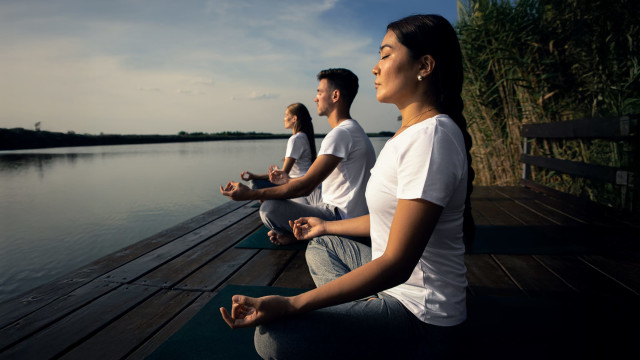Mindful Breathing Isn’t For Everyone

During my first guided meditation, I was asked to focus on my breath. I often felt constricted and almost panicky rather than blissed out and relaxed. This was not what I expected, and I couldn't figure out why focusing on something as simple as my breath negatively impacted my body and mind. But then I started looking for answers and discovered that this type of reaction was quite typical.
Can't 'Hang with' the Breath?
In Buddhism, the breath is a tool to stay focused and anchored to the present moment. It is effective because it's always there, accessible for as long as we live. If we are alive, we are breathing; and if we are breathing, we can focus on this breath to calm our busy minds. But what if following the breath in meditation backfires on you?
Asthma, extensive experience in breathwork, or past trauma, are but three circumstances that might contribute to difficulty following the breath in meditation. Other factors that could keep you from relaxing with your breath include migraines, heart problems, emphysema, diabetes, or anger management. Add in the expectation of sitting perfectly still during meditation or keeping the eyes closed — and all of this can be an actual trigger for some folks. If you count yourself among these, take heart, you're not alone!
The Depths of My Breath
When I was 18 years old, I was diagnosed with asthma. This was quite a shock as I'd always enjoyed staying active outdoors. However, the doctor told me that sometimes, asthma arrived with early adulthood.
Two years later, I was traveling in southern India, and I was introduced to Buddhism through Tibetan people I met living in the mountains of Tamil Nadu. I bought a book called "Buddhist Yoga" by Rev. Kanjitsu Iijima and began my yoga and meditation journey based on its practices.
I learned several intense breathing techniques, including alternate nostril breathing, abdominal breath and other pranayama (yogic breathwork) methods. I ardently adhered to my daily yoga and meditation routines but had no formal teacher at the time. While this was part of the reason I struggled with simply observing the breath, I often felt imprisoned in the tightness of my chest.
As my meditation practice evolved, I went to therapy to heal my childhood trauma. I grew up surrounded by books, nature, art and was raised by creative, passionate parents who loved me dearly. However, their bitter divorce, my father's mental illness, and the accidental death of a sibling all contributed to the ways my young life had shaped me.
I now know that trauma can affect many of us while in meditation. There is a whole new field of study called "Trauma-Informed Mindfulness."
Please check the resources at the end of this article if you're interested.
An Open and Playful Approach
After many years of trying to unsuccessfully befriend my breath, I found a teacher who offered visualizations while working with the breath, along with techniques for grounding in the body for safety and stability. I eventually developed meditation variations of these techniques through experimentation and found ways to observe the breath in meditation without distress. I even discovered a sense of ease and joy while practicing mindfulness of the breath in ways I had previously never thought possible.
Here are some helpful techniques that I've found; if you give them a try, let me know what you think in the comments. And listen to my meditation "Befriending Your Breath" for more guidance.
Anchor in the Body First
You can try grounding in the body by feeling where your feet and seat contact the floor or chair. Experience the solidity of your body, its strength, and its substance. Notice how gravity holds you.
Feel free to keep your eyes open if that is more stabilizing.
Choose a pleasant or neutral location in the body, such as the hands or feet, and place your attention there, noticing any sensations such as warmth, coolness, tingling or pressure. Stay with the sensations on the skin, and after a few moments, try feeling any internal sensations you notice. If there is any sense of pleasantness or relaxation, see if you can imagine that relaxed feeling spreading from the hands or feet to other areas of the body.
Move and Breathe
This is an easy way to experience the natural rhythm of your breath while moving. Try walking at different paces while noticing how many steps you take to each inhale or exhale. There's no right or wrong way to do it – you get to discover what works best for you.
Feel free to try other kinds of movement, like swinging your arms, rocking back and forth, or even dancing while you feel your breath move in the body. When you're ready to take a break, put a hand on your chest or belly and feel the subtle changes as your breath pattern starts to slow on its own.
In this way, you'll get used to letting your breath do its thing naturally as you observe the changes without feeling like you have to control them.
Use Your Imagination
While in meditation, you could try imagining your breath as a constant friend you're observing with a smile rather than a specimen under a microscope. Some people picture the breath as waves breaking and receding on the shore.
Or, you could visualize your attention as a bird lightly gliding on the breeze of the breath. Start by feeling your breath as the wind, flowing naturally, in and out, or back and forth. Then sensing your attention like a small, light bird, riding on the drafts of this wind. The bird of your attention isn't heavy or tight; it's just riding the wind, feeling the updrafts and downdrafts, and being completely free.
Trauma-Informed Mindfulness Resources:
Trauma-Sensitive Mindfulness by David A. Treleaven published by Norton (book)
Trauma-Informed Mindfulness by Jeff Tarrant, Ph.D., Psychology Today (article)
Try this Short and Easy Breath Meditation by cognitive neuroscientist Dr. David Vago to experience how this life force may activate inner peace and calm.
Header Photo: luza studios/E+/Getty Images







